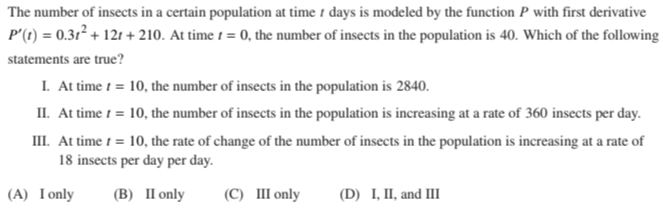The number of insects in a certain population at time 1 days is modeled by the function P with first derivative P'(1) = 0.31² + 121 + 210. At time 1 = 0, the number of insects in the population is 40. Which of the following statements are true? I. At time 1 = 10, the number of insects in the population is 2840. II. At time 1 = 10, the number of insects in the population is increasing at a rate of 360 insects per day. III. At time 1 = 10, the rate of change of the number of insects in the population is increasing at a rate of 18 insects per day per day. (A) Ionly (B) П only (C) III only (D) I, II, and III
The number of insects in a certain population at time 1 days is modeled by the function P with first derivative P'(1) = 0.31² + 121 + 210. At time 1 = 0, the number of insects in the population is 40. Which of the following statements are true? I. At time 1 = 10, the number of insects in the population is 2840. II. At time 1 = 10, the number of insects in the population is increasing at a rate of 360 insects per day. III. At time 1 = 10, the rate of change of the number of insects in the population is increasing at a rate of 18 insects per day per day. (A) Ionly (B) П only (C) III only (D) I, II, and III
Functions and Change: A Modeling Approach to College Algebra (MindTap Course List)
6th Edition
ISBN:9781337111348
Author:Bruce Crauder, Benny Evans, Alan Noell
Publisher:Bruce Crauder, Benny Evans, Alan Noell
Chapter2: Graphical And Tabular Analysis
Section2.1: Tables And Trends
Problem 1TU: If a coffee filter is dropped, its velocity after t seconds is given by v(t)=4(10.0003t) feet per...
Related questions
Question
AP Calculus

Transcribed Image Text:The number of insects in a certain population at time 1 days is modeled by the function P with first derivative
P'(1) = 0.31² + 121 + 210. At time 1 = 0, the number of insects in the population is 40. Which of the following
statements are true?
I. At time 1 = 10, the number of insects in the population is 2840.
II. At time 1 = 10, the number of insects in the population is increasing at a rate of 360 insects per day.
III. At time 1 = 10, the rate of change of the number of insects in the population is increasing at a rate of
18 insects per day per day.
(A) Ionly
(B) II only
(C) III only
(D) I, II, and III
Expert Solution
This question has been solved!
Explore an expertly crafted, step-by-step solution for a thorough understanding of key concepts.
This is a popular solution!
Trending now
This is a popular solution!
Step by step
Solved in 2 steps with 2 images

Knowledge Booster
Learn more about
Need a deep-dive on the concept behind this application? Look no further. Learn more about this topic, calculus and related others by exploring similar questions and additional content below.Recommended textbooks for you

Functions and Change: A Modeling Approach to Coll…
Algebra
ISBN:
9781337111348
Author:
Bruce Crauder, Benny Evans, Alan Noell
Publisher:
Cengage Learning

Functions and Change: A Modeling Approach to Coll…
Algebra
ISBN:
9781337111348
Author:
Bruce Crauder, Benny Evans, Alan Noell
Publisher:
Cengage Learning